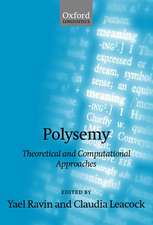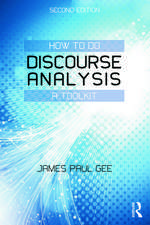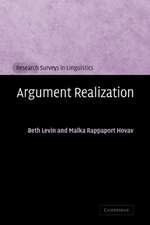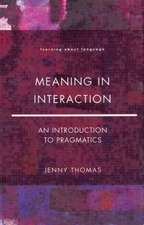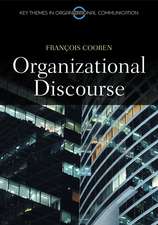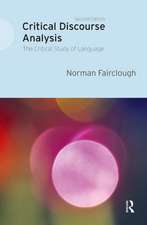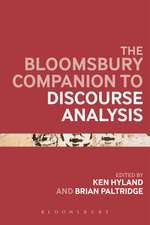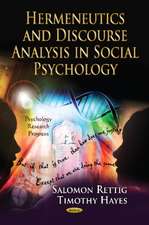Discourse and Narrative Methods: Theoretical Departures, Analytical Strategies and Situated Writings
Autor Mona Livholts, Maria Tamboukouen Limba Engleză Paperback – 27 apr 2015
Illustrated with examples from real life and real research, this book:
- Maps the theoretical influence from poststructuralist, postmodern, postcolonial and feminist ideas on the field of discourse and narrative.
- Acts as a guide to the most central analytical approaches in discourse and narrative studies supported by concrete examples of analytical strategies.
- Presents a variety of oral, textual, visual and other ’data’ for the purpose of analyzing discourse and narrative.
- Offers deeper insight into discourse and narrative methods within three themes of crucial importance for changing global context: media and society, gender and space, and autobiography and life writing.
- Acts as a helpful guide to situated writing based on concrete workshop exercises, which promotes ethical reflexivity, analytical thinking and creative engagement in the study of discourses and narratives.
Preț: 378.53 lei
Nou
72.43€ • 74.73$ • 60.44£
Carte disponibilă
Livrare economică 06-20 martie
Livrare express 19-25 februarie pentru 30.07 lei
Specificații
ISBN-10: 1446269701
Pagini: 232
Dimensiuni: 170 x 242 x 12 mm
Greutate: 0.39 kg
Ediția:1
Editura: SAGE Publications
Colecția Sage Publications Ltd
Locul publicării:London, United Kingdom
Recenzii
We have long needed a good book about how to do discourse analysis and narrative research – and this is it. Livholts and Tamboukou have written a book that is comprehensive, accessible and most importantly practical. It is an invaluable resource for students and teachers of research methods – covering the whole research process from theoretical underpinnings through data collection and analysis.
This book draws together the domains of discourse and narrative theorizing and research methodologies, in a comprehensive and comprehensible way, without offering easy answers to the perennial reductionist question: “What is the difference between narrative and discourse?” Instead, the dialogical structure of the text mirrors the connections and diffractions between the two approaches, offering us the distinct voices of two writers whose work is sometimes in synergy and interwoven, and at other times, departs along parallel lines to explore different terrains. The text is a wonderful contribution in the best tradition of feminist scholarship; a blend of personal stories, political commitments to social justice, and rigorous theorizing.
Lively and engaging, this book opens up powerful new approaches for understanding and enacting discourse and narrative methods. Drawing on their own research experiences, and working with examples of data from across themes of gender and space, media and society, and autobiographical writing, the authors effortlessly blend analysis of theoretical and social contexts with valuable, practical research strategies. Exploring differences and connections across narrative and research methods, Livholts and Tamboukou offer dazzling insights as well as welcome guidance for the beginner and experienced researcher alike. With its compelling storylines and clear-sighted accounts, this book simply stands apart from stock-standard methods textbooks and will fast become a classic reference for anyone grappling with the richness of these methods.
Cuprins
PART I: Introducing Discourse and Narrative Methods
Chapter 1. The Becoming of a Textbook. A Readers Guide
Chapter 2. Theoretical and Methodological Departures in Contested Fields of Study
Chapter 3. Themes: Media and Society, Gender and Space, Autobiography and Life Writing
PART II: Narrative and Discourse: Making Connections
Chapter 4. Narrative Phenomena: Entanglements and Intra-Actions in Narrative Research
Chapter 5. Discourse, Authoring and Performativity
Chapter 6. Narrative Modalities of Power
Chapter 7. Discourse, Power and Representation
Chapter 8. Narrative as force
Chapter 9. Discourses as Embodied Genealogies
Chapter 10. Narrative and the Political
PART III: Situated and Reflective Writing Sessions
Chapter 11. A Politics of Location in Discourse and Narrative Methods
Chapter 12. Working with Diaries and Letters
Chapter 13. Working with Memories
Chapter 14. Untimely Academic Novella Writing
Descriere
Discourses and narratives are crucial in how we understand a world of rapid changes. This textbook constitutes a unique introduction to two major influential theoretical and methodological fields - discourse and narrative methods - and examines them in their interrelation. It offers readers an orientation within the broad and contested area of discourse and narrative methods and develops concrete analytical strategies to those who wish to explore both or one of these fields as well as their overlaps.
Illustrated with examples from real life and real research, this book:
- Maps the theoretical influence from poststructuralist, postmodern, postcolonial and feminist ideas on the field of discourse and narrative.
- Acts as a guide to the most central analytical approaches in discourse and narrative studies supported by concrete examples of analytical strategies.
- Presents a variety of oral, textual, visual and other ’data’ for the purpose of analyzing discourse and narrative.
- Offers deeper insight into discourse and narrative methods within three themes of crucial importance for changing global context: media and society, gender and space, and autobiography and life writing.
- Acts as a helpful guide to situated writing based on concrete workshop exercises, which promotes ethical reflexivity, analytical thinking and creative engagement in the study of discourses and narratives.


